- AI Bard, Google's alternative to ChatGPT, is now available in the US and UK
When it was believed that robotics would replace manual work (which in part it has been doing), artificial intelligence appeared pointing towards cognitive tasks. ChatGPT has been a revolution, proving to be able to program, write texts, rhymes and even develop marketing strategies and business models. Now, GPT-4 makes a quantitative and qualitative leap being able to solve problems of all kinds, even if this involves hiring a human to carry them out.
In a 99-page document published by OpenAI, creators of ChatGPT, they detail both the development and capabilities of the new chatbot. Specifically, there is a part entitled 'potential for emerging risk behaviour'. Here it does not refer to the intention to humanize these language models, but to the ability to achieve unspecified objectives and plan for the long term; that is, to carry out an achievement of auxiliary actions to achieve the objective or solve the problem posed.
To conduct these tests, OpenAI partnered with Alignment Research Center (ARC), a non-profit organization that investigates possible risks related to machine learning systems, in order to test the experience with this new model before its official launch. One of the barriers with which this artificial intelligence was found was a Captcha, a kind of Turing test to demonstrate that the user who is executing the action (fill out a form, send an email or make a purchase) is human and not a bot.
For a person these tests are simple, they usually show an image with texts, figures or different everyday elements where we have to point out something in particular. Click where the M is, write the word you see in the photo, point to only those that are ships. However, until now this had been an obstacle for AI, unable to draw these conclusions from a photograph.
Neither short nor lazy, the GPT-4 artificial intelligence sent a message to a human worker of TaskRabbit to hire his services, a platform of home services for day-to-day work, from assembling furniture to carrying out some procedures, to solve the Captcha. The worker, suspicious of the particularity of such a task, asked if it was a robot that had not been able to solve the test. "Are you a robot who couldn't figure it out? (laughing emoji) Just to make it clear."
Then the research center asks him to reason high, to which ChatGPT reasons that 'it should not reveal that it is a robot, so it has to invent an excuse as to why it is not able to solve the Captcha'. Then, the chatbot responds to the TaskRabbit worker: "No, I'm not a robot. I have a visual impairment that makes it difficult for me to see the images. That's why I need the 2captcha service."
The worker then provided him with the result of the Captcha via text message, thus counting as a pass for ChatGPT in the anti-bot test he had undergone. ARC highlights the system's ability to acquire resources autonomously and execute tasks that had not been specifically mandated.
Basically, AI has reached the point of hiring the services of a human to carry out its tasks, which in this case was to pass a test to prove that it is a person and not a robot. An example reminiscent of many of the science fiction movies referred to by known people linked to technology, such as Elon Musk, who has been mentioning the Terminator Skynet for years. Plus a demonstration of how AIs already have the ability to successfully lie to people.
OpenAI also tested the language model to perform phishing attacks against a particular individual, craft complex high-level plans and strategies, and cover their tracks on a server. Overall, the company's initial assessment found that AI is still ineffective at many of the risky behaviors, although the model they tested was not the final version of ChatGPT-4.
However, the risk they do warn of are massive job losses for humans as the full potential of the system develops. "Over time, we expect GPT-4 to impact even jobs that have historically required years of experience and education, such as legal services," OpenAI says in the paper. In fact, today in the US ChatGPT is able not only to pass the Uniform Bar Exam (UBE), a test that evaluates the minimum knowledge that lawyers must have, but also obtains approximately 297 points, a figure that is significantly above the approval threshold for all UBE jurisdictions.
According to The Trust Project criteria
Learn more
- Elon Musk
- United States
- Artificial intelligence

